|
Only about half of smokers are ever advised to quit smoking by their physicians. The Agency for Health Care and Policy and Research recommends that physicians should discuss the dangers of smoking with their patients and should continue to encourage them to quit at every office visit.
Physicians are in an ideal position to advise against smoking because 70 % of smokers see their primary care physician about three to four times a year. Research indicates that success rates for unaided smoking cessation doubles from 5% to 10% of attempts when instigated by simple advise to quit from the clinician.
Yet, the literature continues to document the failure of physicians and other healthcare professionals to intervene with all of their patients who smoke, with only half of current smokers reporting having been encouraged to quit and even fewer receiving specific counseling.
Healthcare settings provide an important teachable moment for smoking cessation intervention. Seventy-five percent of the adult population visits a physician at least once a year, with the average adult making five visits per year. In the physician's office, patients are often conscious of their health and most receptive to risk factor intervention, providing an important opportunity for change.
A number of studies have documented that physician-delivered counseling interventions for smoking cessation can be effective. However, these studies have also documented that two factors are especially important:
- the physician (or other healthcare professional) should receive skill-building training in counseling methods, and
- an office system that facilitates delivery of such counseling and enhances its effect must be in place.
The following, published by the American Heart Association, describes what a Minimal Intervention in smoking cessation should contain:
- Ask about smoking.
- Recommend cessation (or if a patient is a child or teenager, not starting).
- Help patients who want to stop smoking (provide audiovisual and/or print materials, refer to smoking cessation specialist or other trained office support personnel, provide a list of community resources).
- If possible, schedule a quit date.
- Arrange for follow-up.
There is overwhelming evidence demonstrating both the cardiovascular hazards of smoking and the prompt benefit that occurs with smoking cessation. The provision of advice alone significantly increases the smoking cessation rate, and even minimal counseling yields a further benefit.
Intervention with patients who have already suffered a cardiac event yields particularly striking benefits.
- The smoking status of all patients should be assessed and appropriate intervention offered to those who smoke.
The importance of ensuring the delivery of smoking cessation counseling was recognized when smoking counseling assessments were incorporated into version 3 of HEDIS, the Health Plan Employer Data Information Set of the National Committee for Quality Assurance (NCQA).
The Smoking Cessation template can be found from either The LESS Initiative on AAA Home or from the Main Tool Bar Template Icon.
LESS Initiative


- When the Template button is clicked you will be presented with the preference list.
- If the Smoking Cessation Template is listed as one of your preferences, select it.
- If it is not one of your preferences, select the All radio button and scroll down until you find it in the list. Then you may select the template by either double-clicking on the name or single click on the name (so that it is highlighted in blue) and then click the OK button.
NOTE: For more on how to set up your preferences, Click Here
The organization and content of the template is as follows:
The top section is organized into three columns:
Top Column 1 -
At the top left is an alert which states Red = Required Field
This is followed by the only required field which states
- Patient currently smokes? Yes No
Following in the first column are functions to document:
- Pipe? Yes No
- Smokeless Tobacco? Yes No
- Date Stopped Smoking?__________
- Packs per day?_____ Years?______
Note: These functions interact with the History Template if they have been completed there.
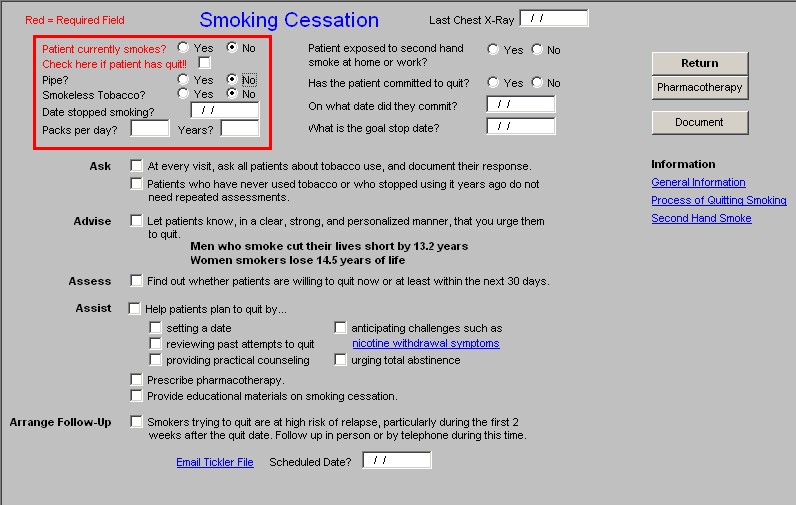
Top Column 2 -
A box where the date of the Last Chest X-ray is automatically documented.
There are then four data points for completion:
- Patient exposed to second hand smoke at home or work? Yes No
- Has the patient committed to quit? Yes No
- On what date did they commit? A calendar box is present for documentation
- What is the goal stop date? A calendar box is present for documentation
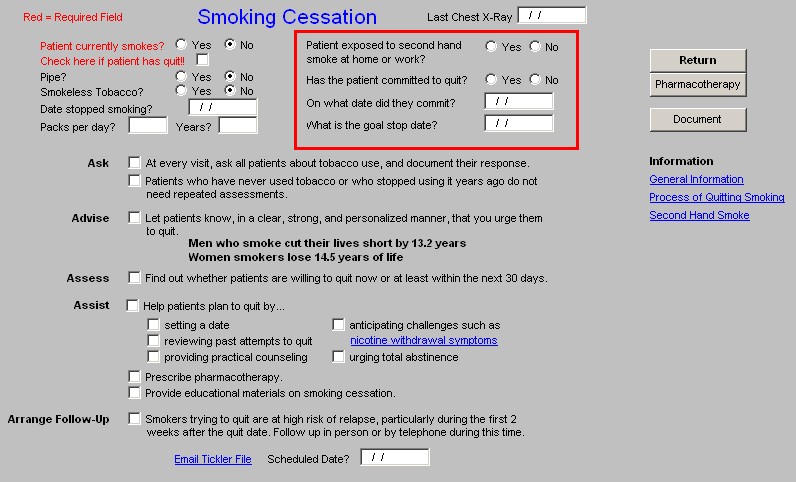
Top Column 3 -
- Return Button for navigation back to the LESS Initiative
- Pharmacotherapy - this button launches a review of medications for smoking cessation. This is described below
- Document - this button launches the development of the Smoking Cessation document which also contains information on each element of the program which applies to this patient, i.e.:
- General Information
- Process of Quitting Smoking
- Second Hand Smoke
- Nicotine Withdrawal
- Information - the following three documents can then be printed, if there is every a need to do so apart from the completion of the Smoking Cessation document.
- General Information
- Process of Quitting Smoking
- Second Hand Smoke
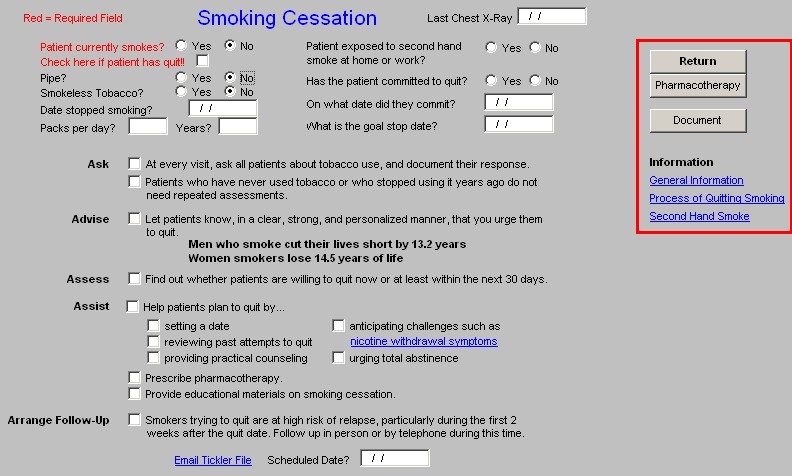
The second section of the template from top to bottom allows the provider to follow a classic behavioral modification pattern, i.e., "Ask," "Advise," "Assess, "Assist, "Arrange"
Under "Ask" there are two steps, each of which should be checked marked, if the provider has taken these steps:
- At every visit, ask all patients about tobacco use, and document their response
- Patients who have never used tobacco or who stopped using it years ago do not need repeated assessments.
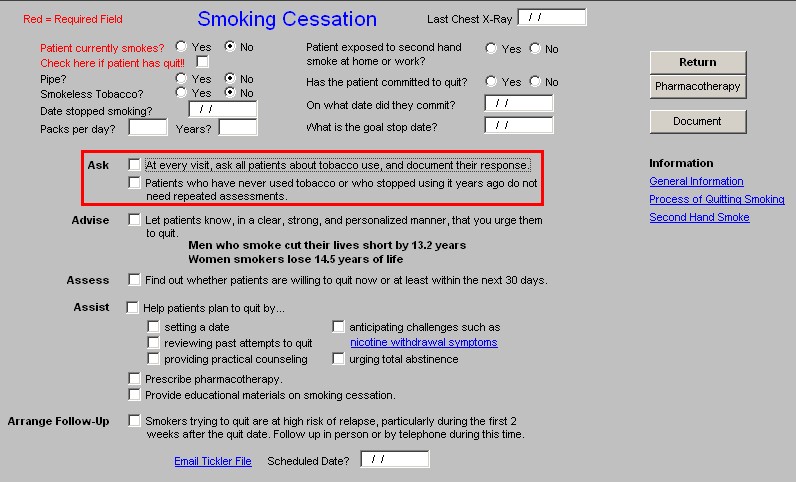
Under "Advise" there is one opportunity to document an action taken to intervene in the patient's smoking. It states:
- Let patients know, in a clear, strong, and personalized manner that you urge them to quit.
The following facts which appear on the template are helpful in the "Advise" phase of the Smoking Cessation encounter:
- Men who smoke cut their lives short by 13.2 years
- Women who smoke lose 14.5 years of life.
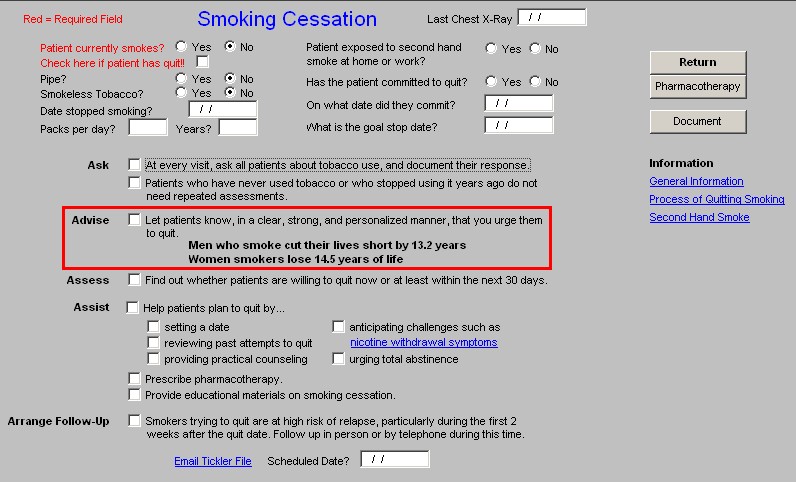
Under the "Assess" phase of the Smoking Cessation encounter, there is one point of documentation:
- Find our whether patients are willing to quit now or at least within the next 30 days.
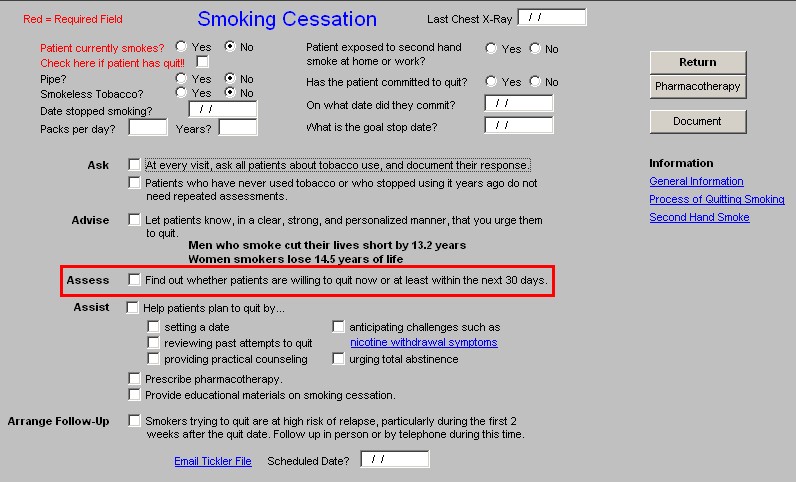
Under the "Assist" phase of the Smoking Cessation encounter, there are the following opportunities to document aspects of the effort:
- Help patients plan to quit by.
- Setting a date
- Reviewing past attempts to quit
- Providing practical counsel
- Anticipating challenges such as nicotine withdrawal symptoms
- Urging total Abstinence
Note: The nicotine withdrawal symptom provides a document to give to the patient by clicking on those words.
- Prescribe pharmacotherapy
- Provide educational materials on smoking cessation
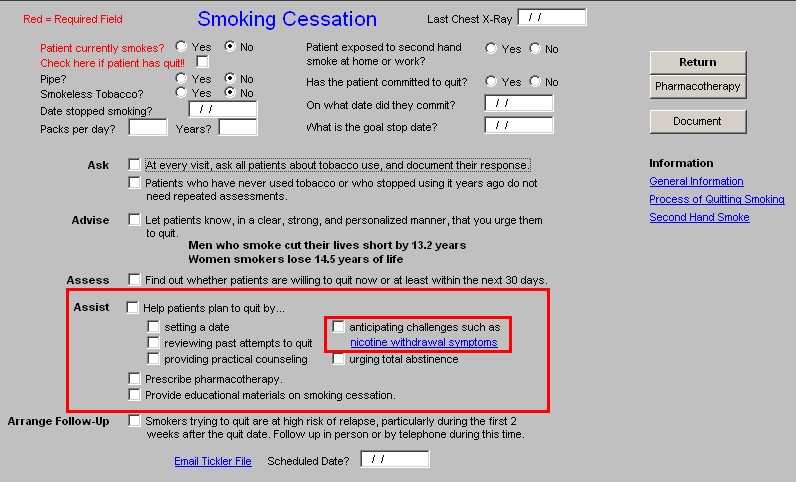
The "Arrange Follow-up" phase of the Smoking Cessation encounter provides the following opportunity for documentation:
- Smokers trying to quit are at high risk for relapse, particularly during the first 2 weeks after the quit date. Follow up in person or by telephone during this time.
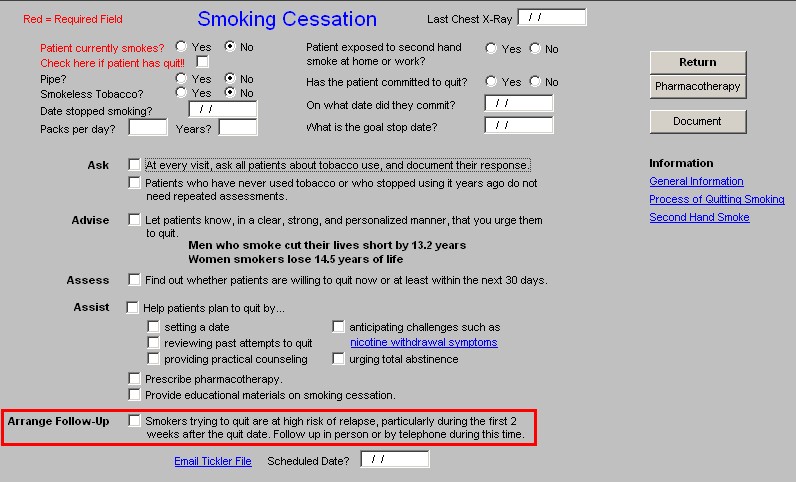
Beneath this is a link entitled Email Tickler File with a Scheduled Date Box next to it.
- When the "Email Tickler File" is clicked, a pop-up appears which gives the 8 steps to creating an electronic tickler file.
- When OK is clicked an e-mail is launched.
- Click on the option "this template," and then click OK
- This launches an e-mail which has the following information on it:
"Please contact Test IBM Serv AAA to confirm that she has stopped smoking. Her home telephone number is 4098354550. If she has stopped smoking, please congratulate her. If she has not, but is making a good faith effort, please let her know that we will contact her again in one month. She must have stopped by then. Let her know that her healthcare provider will be notified of her progress or lack thereof. Create a follow-up electronic tickler file for one month hence. Notify the provider of the patient's response."
- Put your nurse or your unit clerk's name in the "To" space, then click on Options.
- Select the option "To Not Deliver Before."
- Select a date one month from this date.
- Click "send."
- This e-mail will then appear on your unit clerk's desktop on the date selected.
- When the nurse or the unit clerk calls the patient, the content of that call will be documented and the e-mail will be placed in the patient's EMR record. For more information on setting up an Email Tickler in the EMR, Click Here For information on how to put an e-mail in the EMR, Click Here
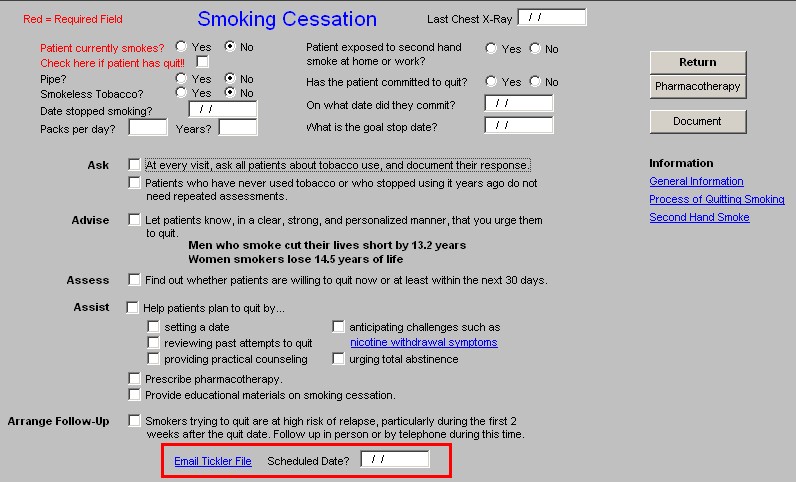
Pharmacotherapy
When the Pharmacotherapy button is depressed on the Smoking Cessation Template, it launches a template entitled, "Smoking Cessation Pharmacotherapy."
At the top, the following statement appears:
Because tobacco dependence clearly meets all criteria for a drug dependence disorder, the guideline panel concluded that it is inappropriate to reserve pharmacotherapy until patients have tried to quit on their own; because 95% of these unaided quit-attempts fail.
At the left-hand side of the template are six documents which provide facts about medications used in smoking cessation; under the heading First-Line Pharmacotherapy are:
- Bupropion, sustained release (SR)
- Nicotine Patch
- Nicotine polacrilex (gum)
- Nicotine inhaler
- Nicotine nasal spray
- Nicotine lozenge
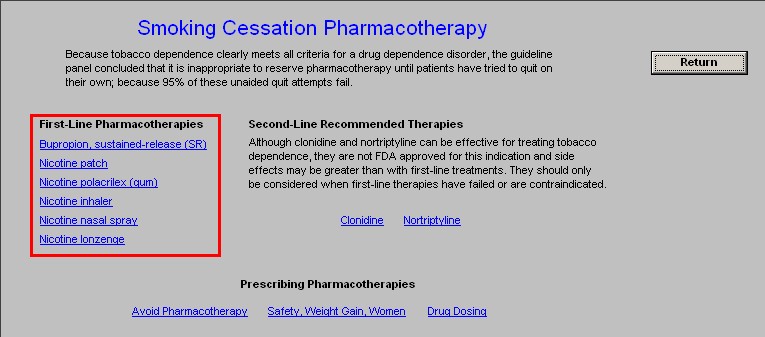
Under the heading Second-line Recommend Therapies is the following statement:
Although clonidine and nortriptyline can be effective for treating tobacco dependence, they are not FDA approved for this indication and side effects may be greater than with first-line treatments. They should only b considered when first-line therapies have failed or are contraindicated.
Below this statement are two links which launched documents about the named drug:
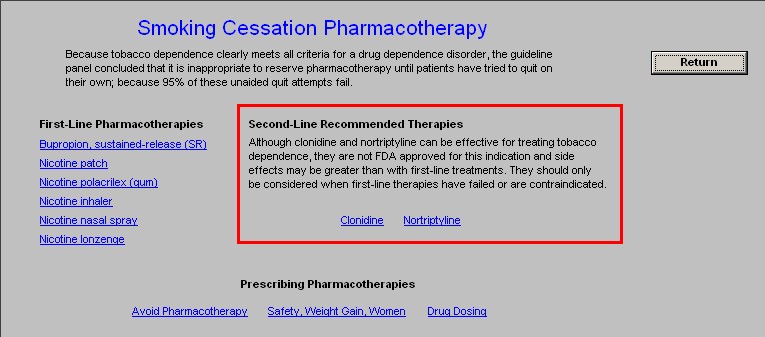
At the bottom of the template is a section entitled Prescribing Pharmacotherapy.
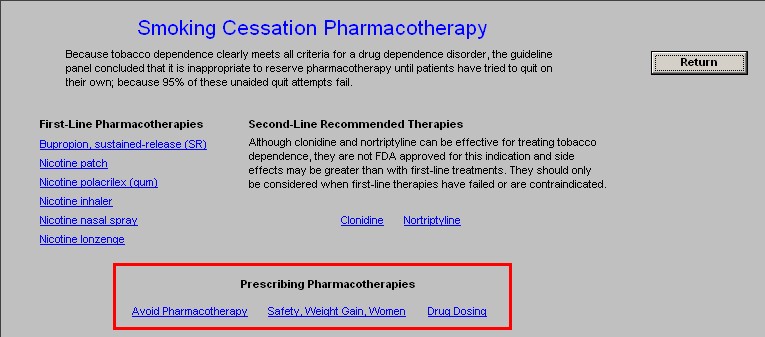
There are three buttons which launched different functions:
- Avoid Pharmacotherapy - this lists four circumstances in which pharmacotherapy is not indicated. They are:
- Those smoking fewer than 10 cigarettes per day
- Women who are pregnant
- Women who are breastfeeding
- Adolescent smokes
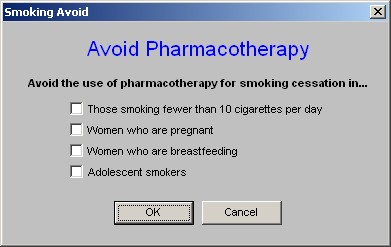
- Safety, Weight Gain, Women - this list five considerations about drug treatment of nicotine`; they are:
- Patients with cardiovascular disease may safely receive any of the therapies
- Buproprion SR or nicotine gum may reduce, but not prevent, weight gain - a consideration in patients concerned bout this issue.
- Prescribe lower dosages of any therapy for relatively light smokers (10-15 cigarettes daily), although dosage changes are not necessary for buproprion SR.
- Depressed patients should consider buproprion SR or nortriptyline first.
- Women smokers may be more successful with buproprion SR.
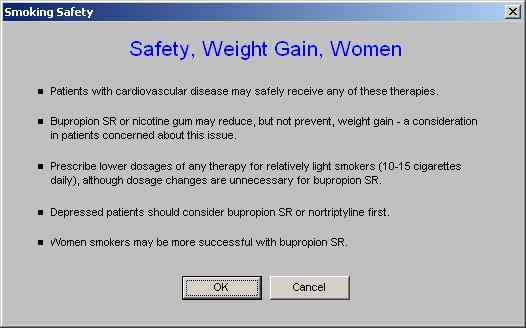
- Drug Dosing - this launches an electronic PDR for information about each of the First and Second-line drugs discussed above. When the appropriate drug is selected by checking the box next to it, the following information is populated into boxes with the names:
- Precautions/contraindications
- Side effects
- Dosage
- Duration
- Buproprion, sustained release
- Nicotine gum
- Nicotine inhaler
- Nicotine nasal spray
- Nicotine transdermal systems
- Nicotine lozenge
- Clonidine
- Nortriptyline

|